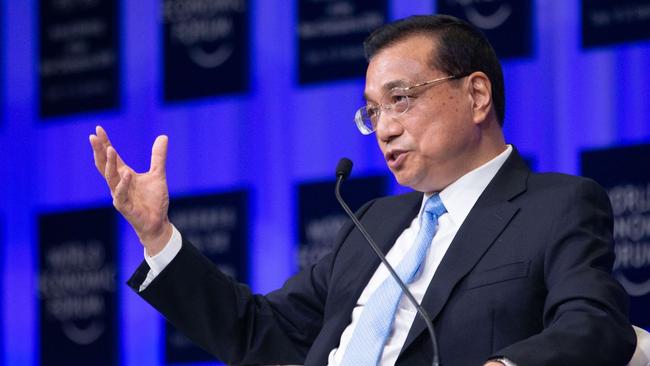China slowdown near ‘crisis point’
Oxford Economics expects China’s growth to slow to about 6.1pc this year, but others warn of a much sharper slowdown.

While Australia is gradually getting back to work, the debate in China is intensifying on just how much its economy is set to slow down this year.
Trade figures released this week are the latest evidence of a weakening Chinese economy as Beijing also faces pressure from the US and other Western governments over its trade policies and moves to constrain the growth of Chinese tech companies such as Huawei and ZTE.
China’s exports fell by 4.4 per cent year-on-year basis in December — the worst result since 2016 in US dollar terms — under pressure from a slowdown in global trade growth and the increasing impact of US trade sanctions.
Imports for the month were down by 7.6 per cent compared with a year earlier, a figure being seen as further evidence of the slowdown in the economy.
Analysing the figures, Oxford Economics said it expected the slowdown to be reflected in continued lower imports in coming months.
“We do not want to overinterpret one month of weak data,” Oxford Economics said.
“But on the back of feeble news on China’s economy in recent months, the data seems to confirm the slowdown in Chinese demand.
“The import slowdown is consistent with other signs that growth in China’s domestic economy continued to weaken.
“We think overall economic growth slowed further in the fourth quarter of 2018 and remains under pressure from weaker exports, slow credit growth and cooling real estate activity in the first half of 2019.”
The consulting firm is expecting China’s economy will slow to around 6.1 per cent this year from 6.6 per cent in 2018.
But a growing number of forecasters are now expecting a much sharper underlying slowdown.
While China’s policymakers have a wide range of tools to stimulate the economy, the true impact of the trade war has yet to really hit China. There was actually a mini-boost to exports in the middle of last year as exporters rushed goods to the US ahead of the imposition of higher tariffs.
Chinese exports are already subject to higher US tariffs on more than $US200 billion ($277bn) imposed last year and face the prospect of US President Donald Trump imposing more tariffs if trade talks between the two fails. There is also the more long-term impact of the trade war accelerating trends by US companies already under way to reduce their exposure to Chinese-made components and products.
Regardless of whether the US and China reach a trade deal by March 1 — which is expected — fears of future political fallout from ongoing tensions is fundamentally changing the old China-based, global supply chains now in place, with buyers and manufacturers alike looking to move manufacturing to Vietnam, Thailand and other low-cost countries in Asia.
China’s official growth target for the year is expected to be set between 6 per cent and 6.5 per cent, compared with last year’s target of “around 6.5 per cent”.
But the financial markets are no longer looking to official growth figures for comfort.
There is also the more subtle but corrosive impact of the steady drip of negative news and attacks on China on business confidence in the country and on foreign companies doing business with China.
In recent weeks, Poland has become one of the latest countries to call for bans on the use of Chinese telecommunications equipment for 5G network rollout, following on warnings in Australia, the US, Japan and Britain.
Canadian citizens in China were warned yesterday that they faced increased risks of arbitrarily coming under scrutiny for potential breaches of the law, as analysts express concern that the arrest of Huawei’s chief financial officer, Meng Wangzhou, in Canada in December could lead to retaliation against businesspeople travelling or doing business in China.
The profit warning by Apple chief executive Tim Cook, who blamed the slowdown in the Chinese economy for the company’s lowered outlook, is a sign that Western multinationals can no longer rely on growth in demand from China to sell their goods.
Commenting on this week’s trade figures, US-based China watcher Bill Bishop argued that the data provided added pressure on Chinese negotiators to reach a deal with the US administration.
“The figures set a grim domestic backdrop for China’s negotiators as they seek a deal to end the standoff with the Trump administration,” he wrote in the latest edition of his newsletter, Sinocism.
Chairing a plenary meeting of China’s State Council earlier this month, Premier Li Keqiang acknowledged that China faced a more complicated environment this year including downward pressure on the economy.
Writing in the South China Morning Post yesterday, David Brown, chief executive of research consultancy New View Economics, warned that Beijing needed to be prepared for the prospect that China’s economic growth could slow down to as low as 2 per cent.
“China’s growth slowdown is reaching crisis point,” he wrote.
“Its GDP could well end up outside the consensus range of expectations, which has been between 5 and 7 per cent.
“Negative forces are building and China could hit a brick wall very soon with economic expansion collapsing, sinking to as low as two per cent in a worst-case scenario.”
He pointed to weak car sales in China last year, lacklustre property sales, “listless” consumer confidence and the fall in the Chinese stock markets, along side other world economic events, as pointing to “a mess with no apparent happy ending”
While Brown is clearly far too pessimistic, his comments are sign of the times as those inside and outside China brace themselves for a tough and rocky 2019.



